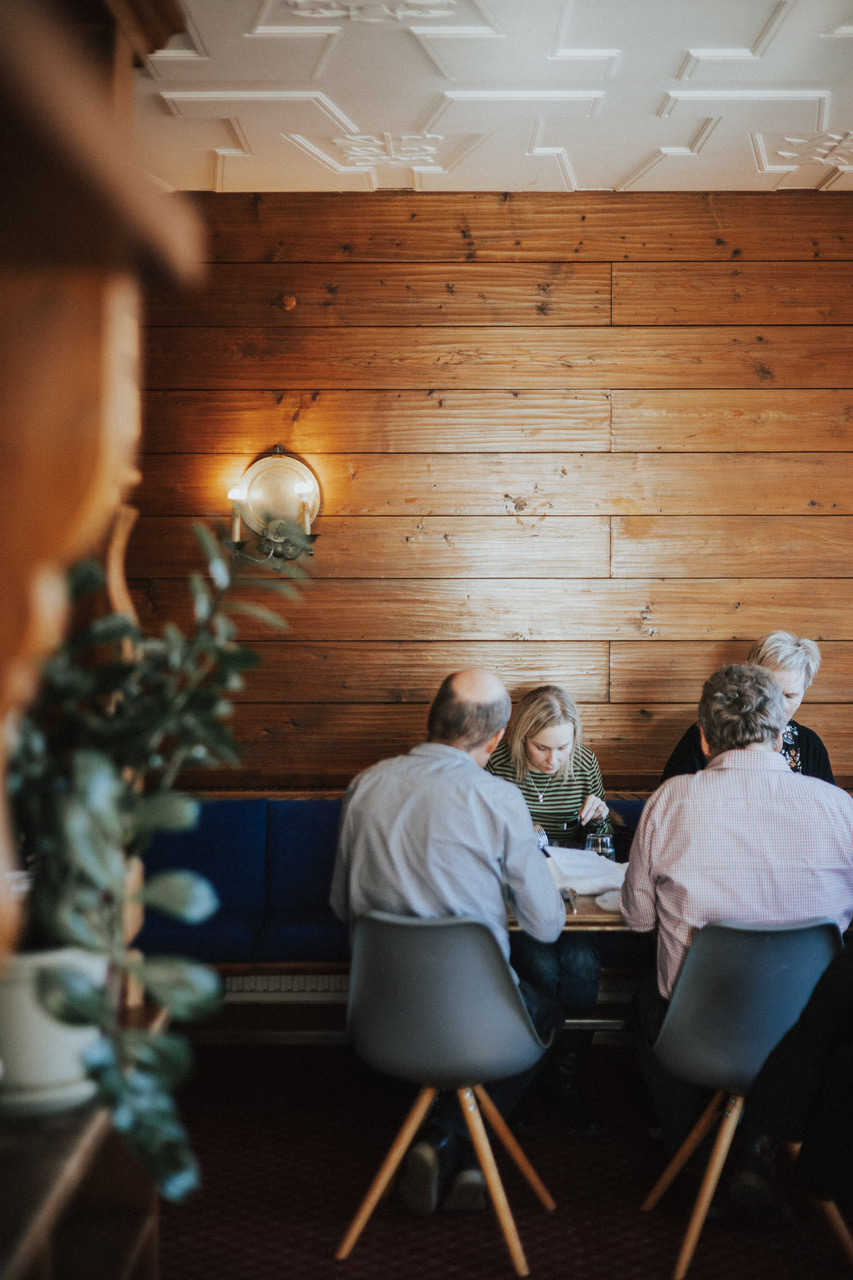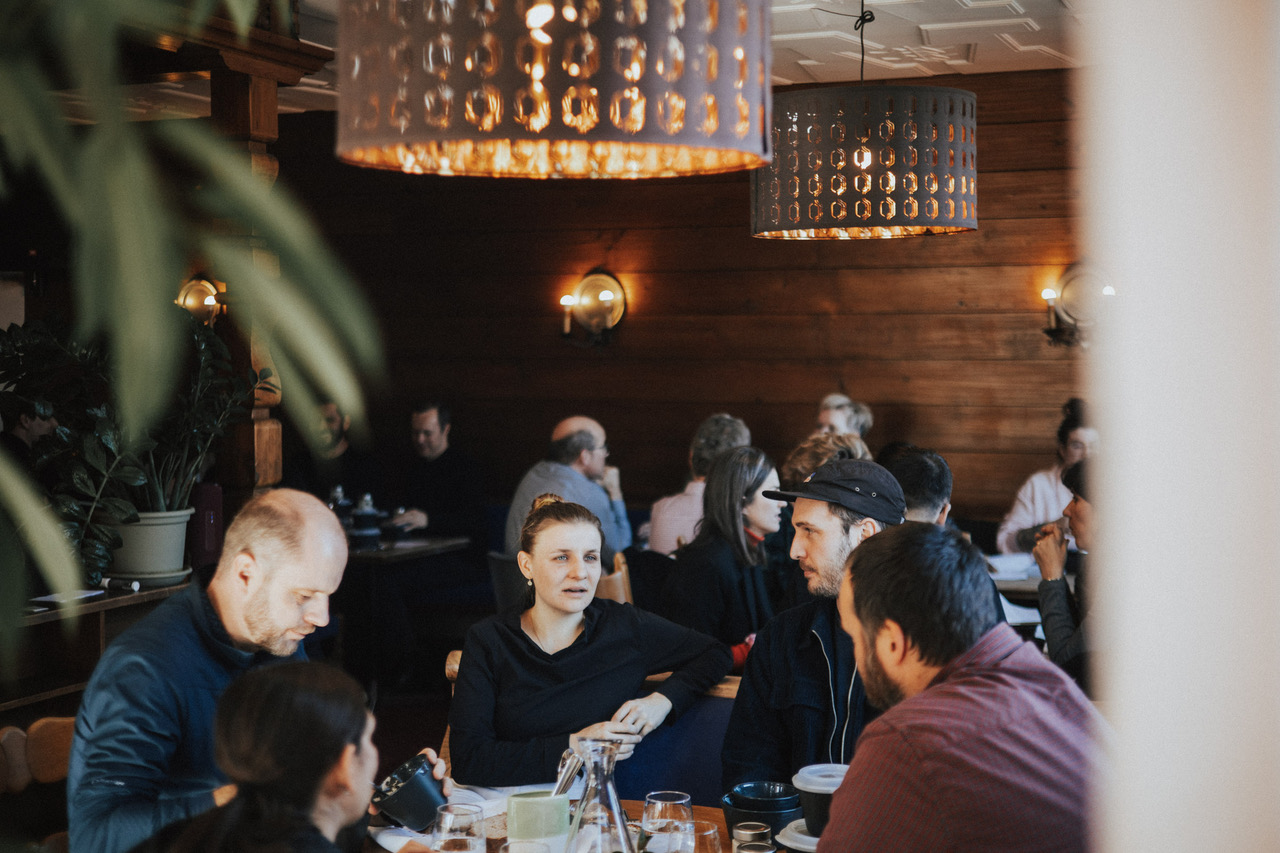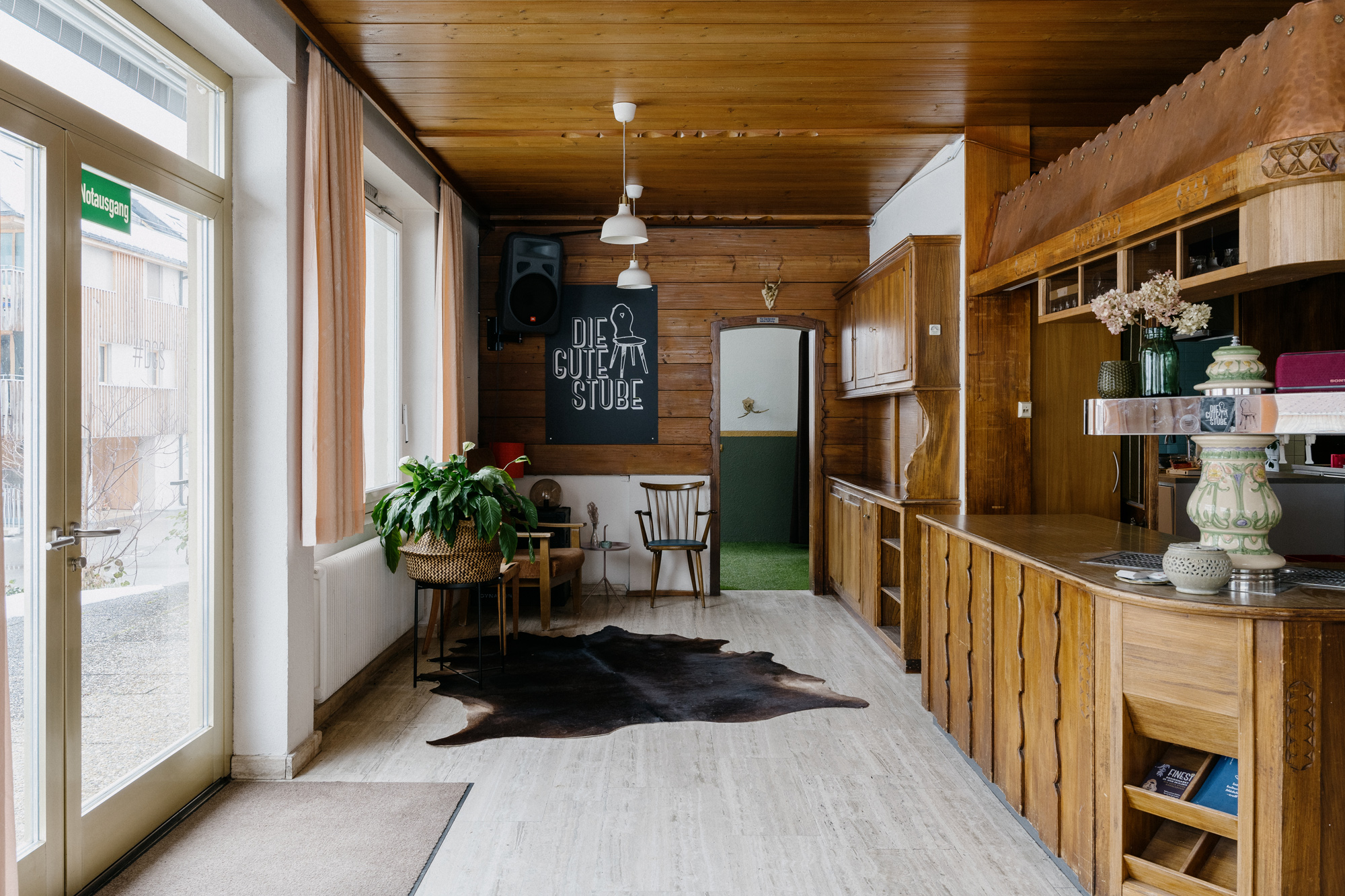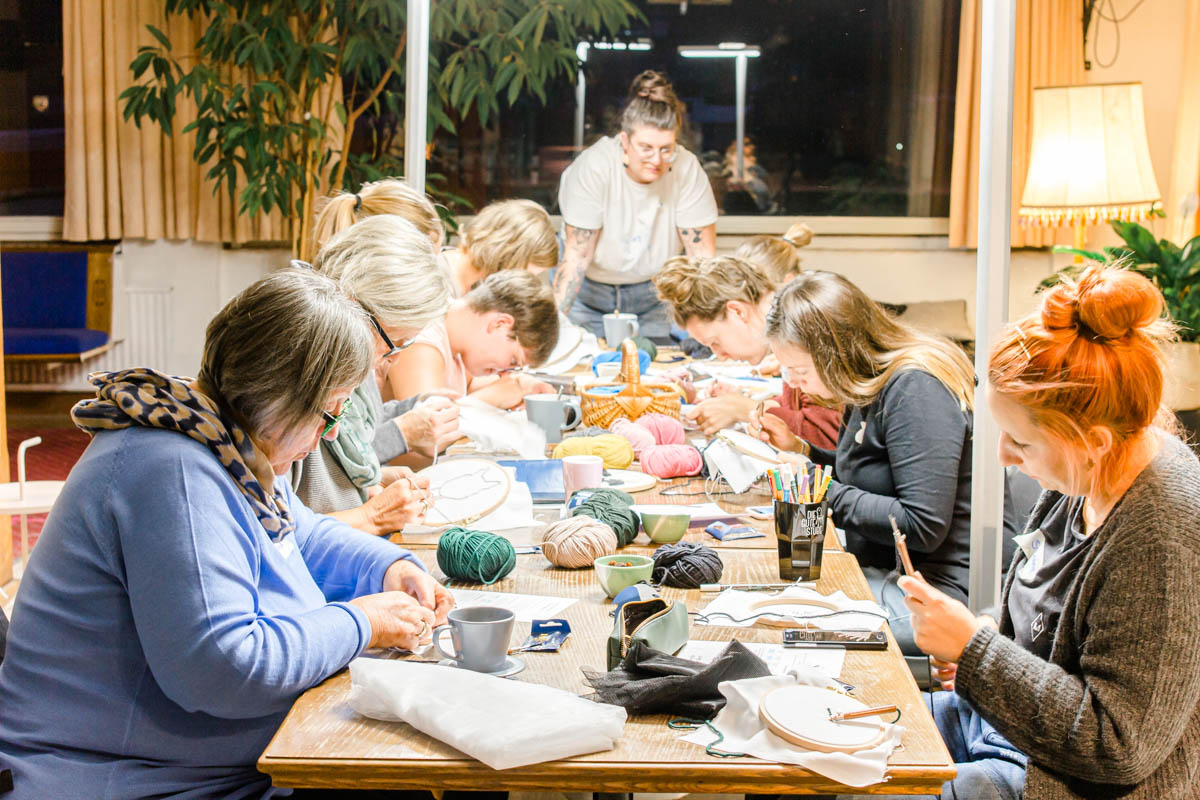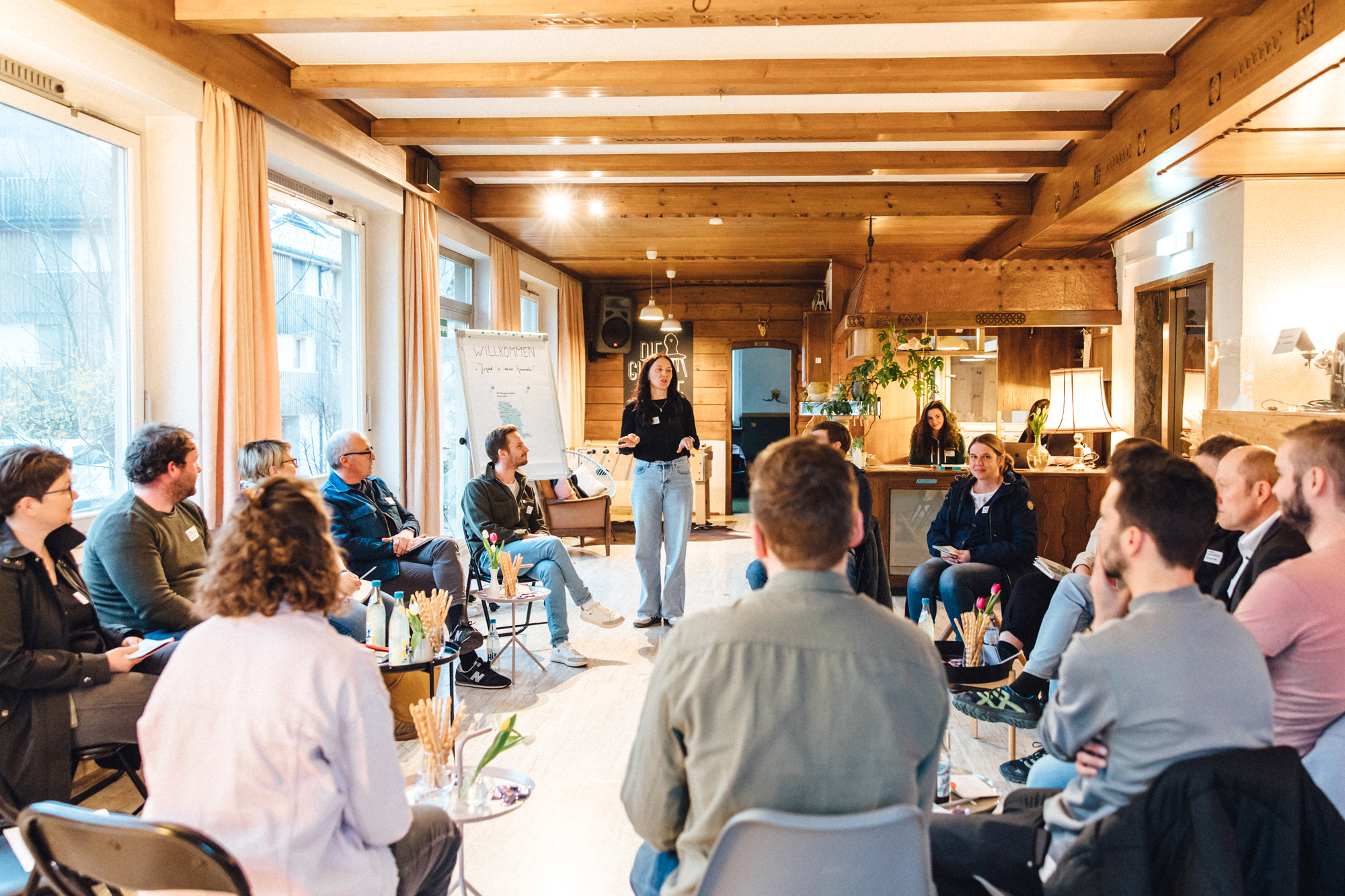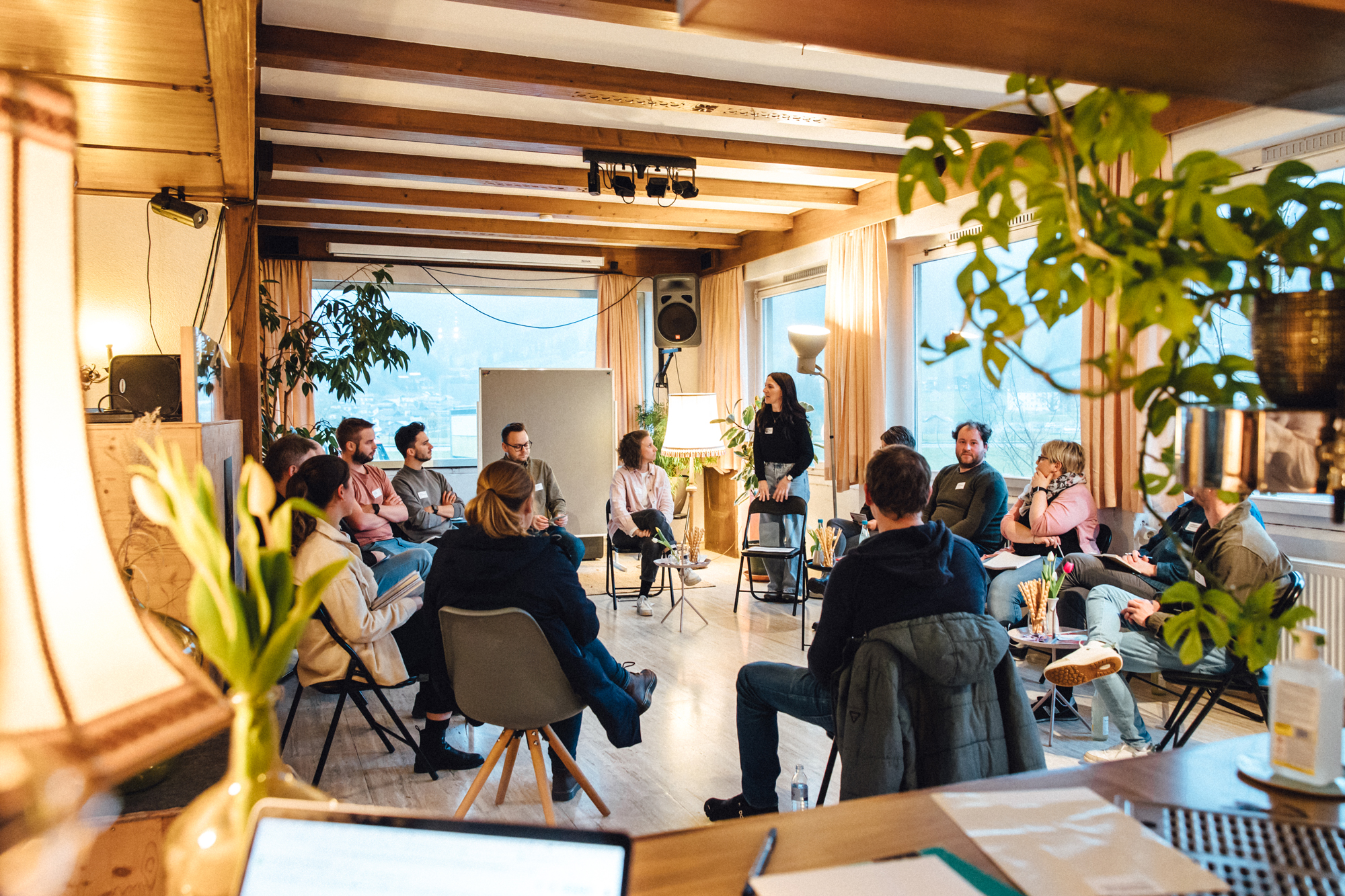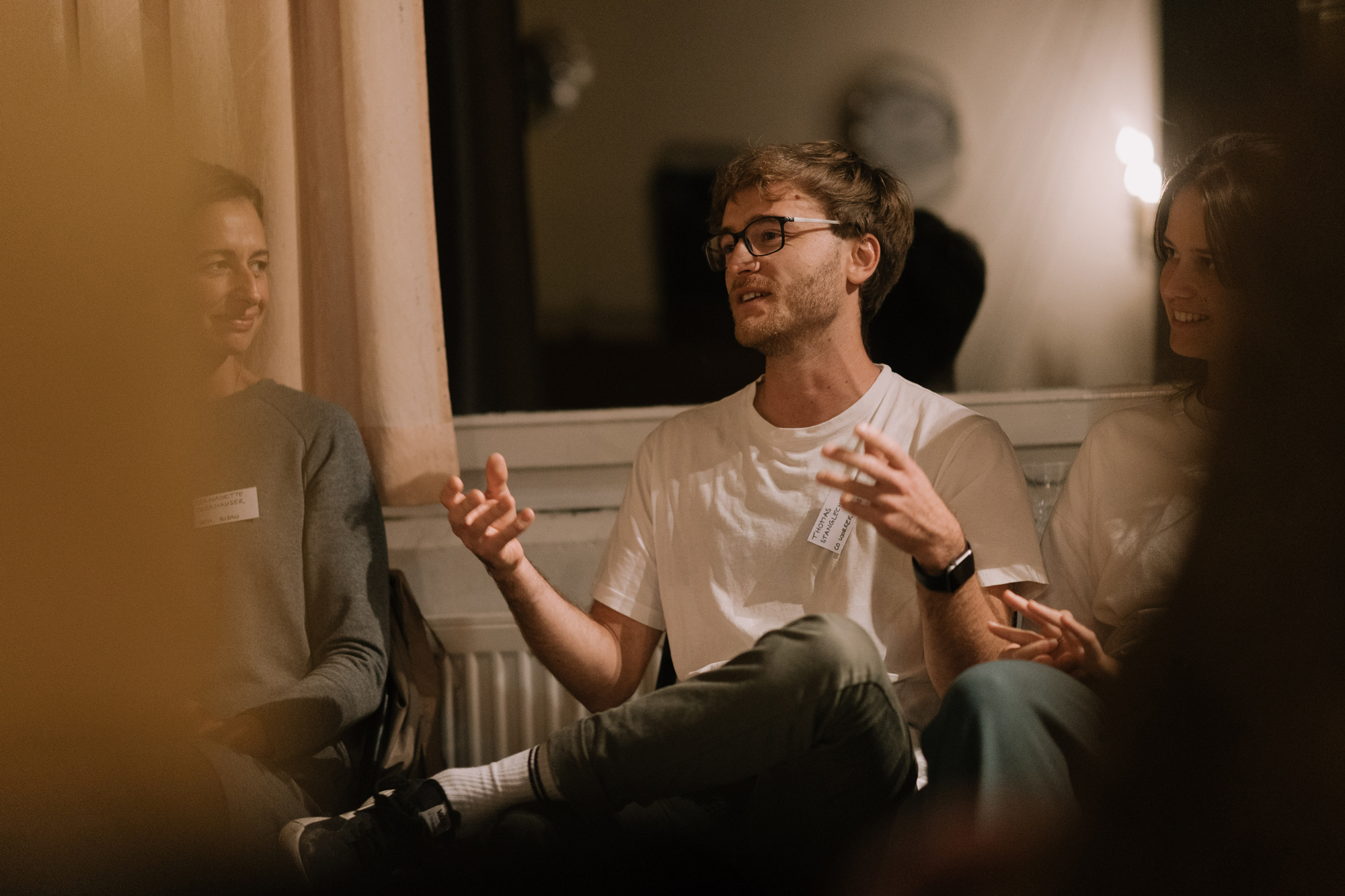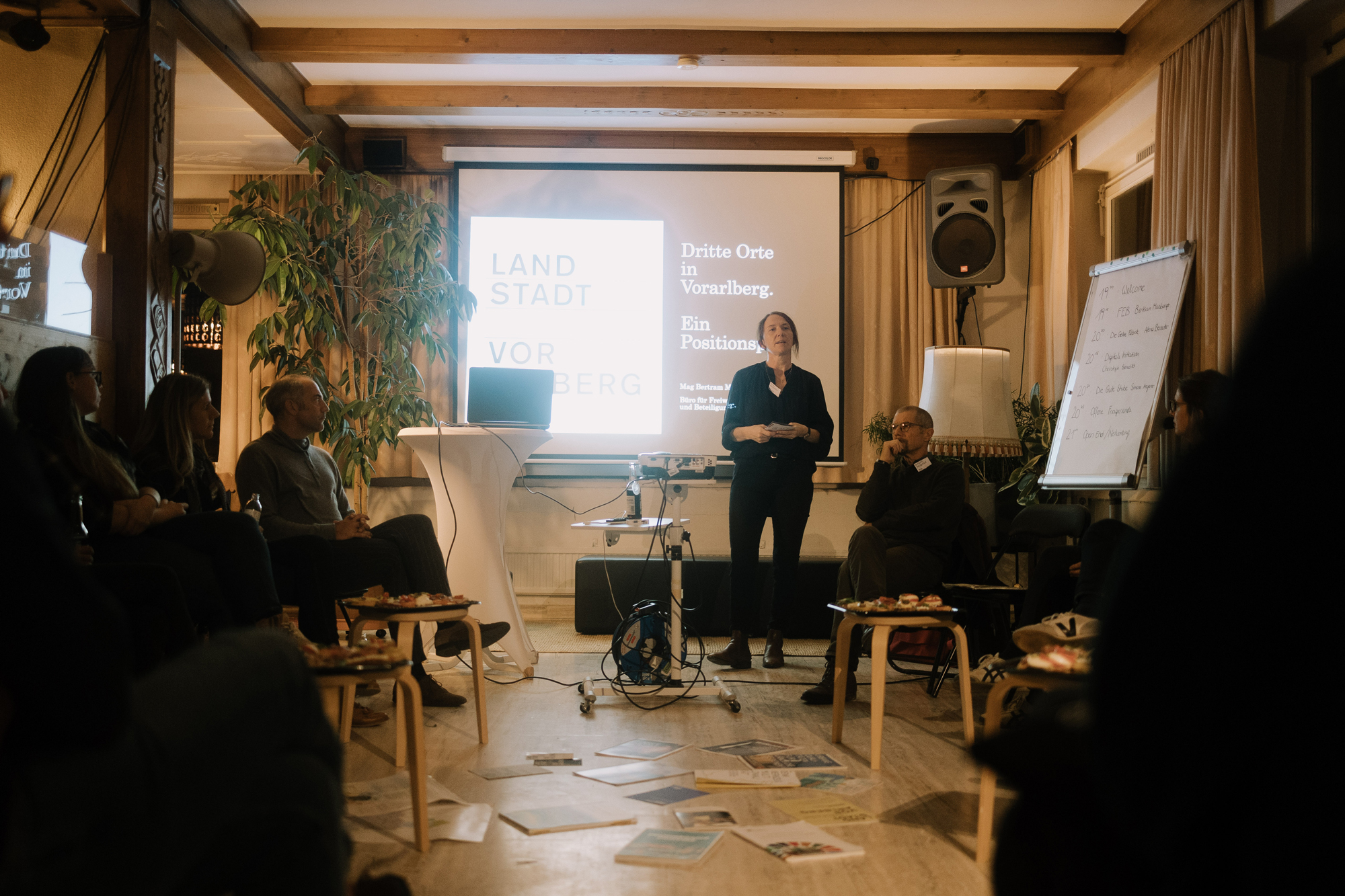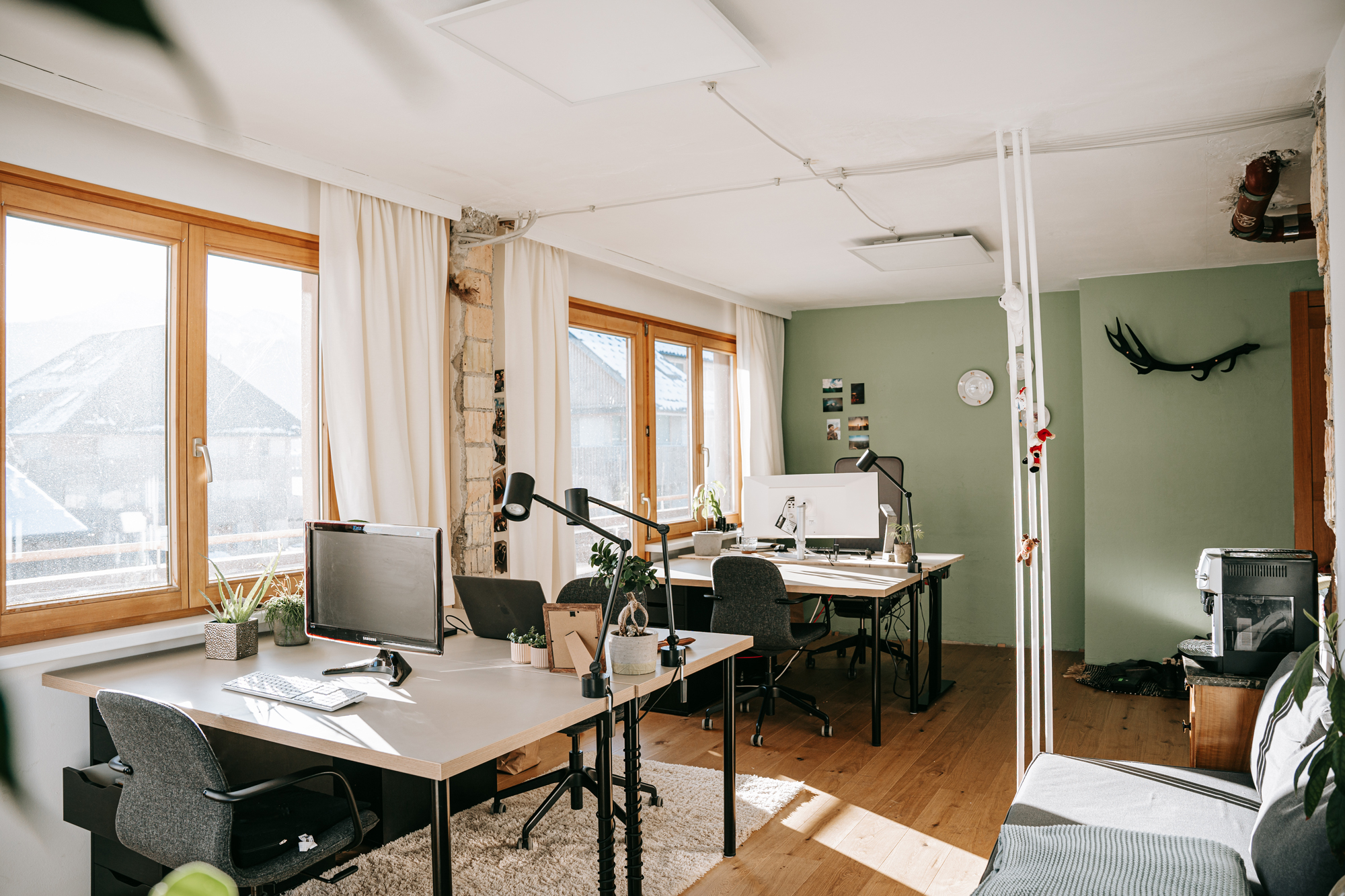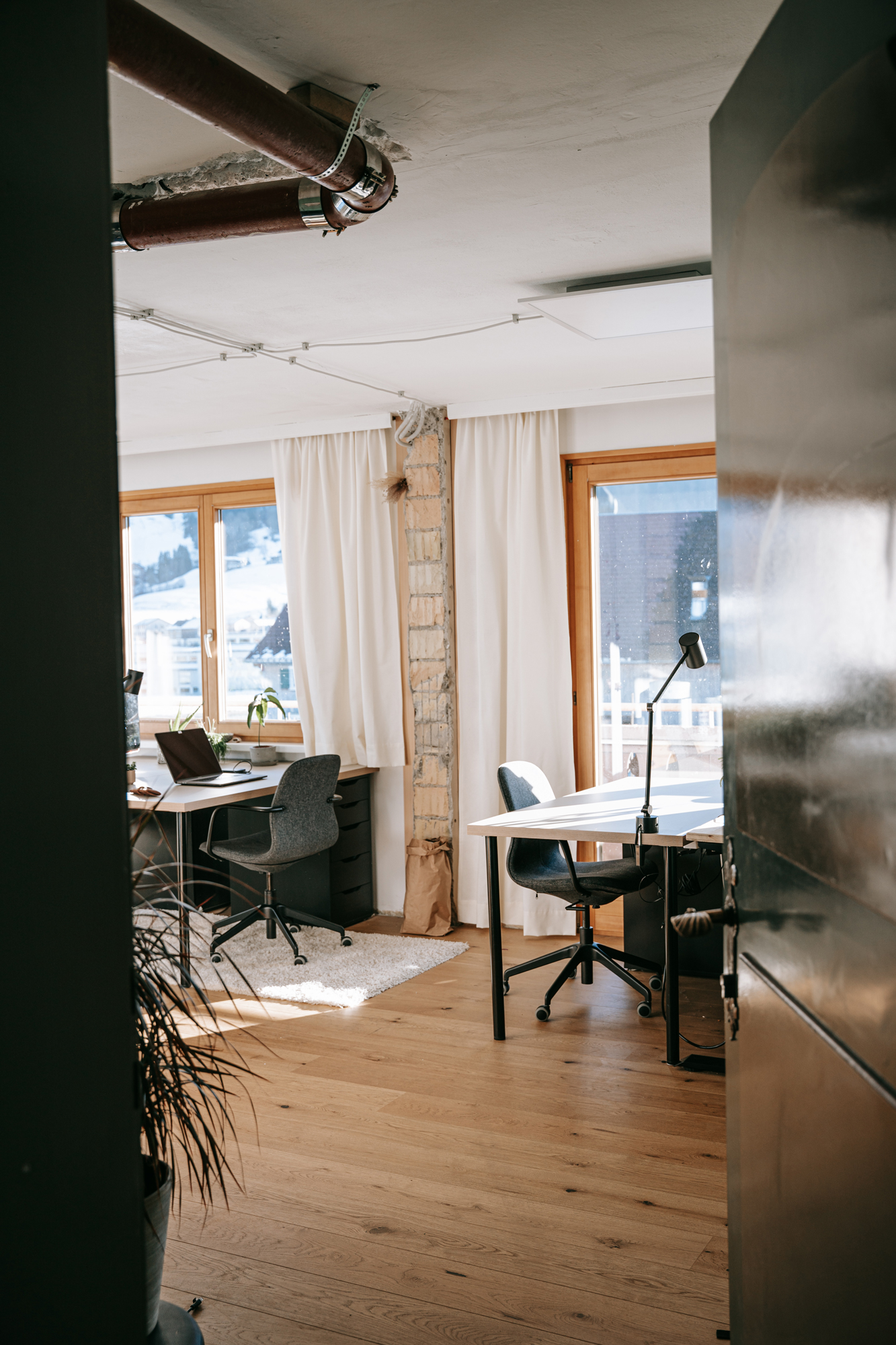Regaining a sense of belonging
Die Gute Stube
Die Gute Stube – Revitalizing Spaces & Strengthening Belonging Through Culture, Exchange & Community
"Die Gute Stube" revitalizes vacant spaces and strengthens young people's sense of belonging in the Bregenzerwald region. Housed in a former hotel, it has become a unique space for culture, exchange, and entrepreneurship. As an open meeting and creative hub, it connects generations, tradition, and innovation. It fosters new ideas, social networks, and cultural impulses – a vibrant place where young people actively shape their surroundings and experience a strong sense of community.
Austria
Regional
The project is implemented at a regional level in the Bregenzerwald (includes 24 villages) area of Austria. It primarily serves the local youth and community in Andelsbuch while also attracting participants from surrounding villages and the broader region. As a best-practice example, it has the potential to inspire similar initiatives in other rural areas.
Mainly rural
It refers to a physical transformation of the built environment (hard investment)
Yes
2019-02-28
Yes
LES 14-20
No
No
As a representative of an organisation
Die Gute Stube is a community-driven initiative in the Bregenzerwald region, Austria, designed to strengthen belonging through culture, exchange, and creativity. As a recognized Third Place, it provides a flexible space bridging social, cultural, and professional interactions. The project revitalizes a vacant former inn into a dynamic hub, fostering cultural participation, inclusion, and local identity. By preserving regional heritage while creating new opportunities, it addresses the region’s lack of cultural infrastructure and youth spaces.
Die Gute Stube primarily serves young people but also engages creatives, entrepreneurs, and residents of all generations. It creates an inclusive space where individuals connect, collaborate, and shape their community’s cultural and social fabric. Through its adaptive reuse approach, the project supports sustainability by repurposing existing infrastructure while fostering long-term social impact. Objectives include revitalizing underutilized spaces, fostering cohesion, promoting youth-driven initiatives, and strengthening regional identity. Additionally, it serves as a best-practice model for Third Places across Austria, sharing experiences with small municipalities and stakeholders while engaging in cross-border networking.
The project’s outcomes include transforming a heritage building into a vibrant community space, increasing cultural engagement, strengthening youth participation, and creating social and entrepreneurial opportunities. It exemplifies New European Bauhaus values, integrating sustainability, inclusion, and aesthetics. Die Gute Stube ensures a sustainable, resilient community model by fostering cultural participation and knowledge exchange. By offering expertise on Third Places at national and international levels, it contributes to innovative rural development and helps communities create meaningful engagement spaces.
Die Gute Stube primarily serves young people but also engages creatives, entrepreneurs, and residents of all generations. It creates an inclusive space where individuals connect, collaborate, and shape their community’s cultural and social fabric. Through its adaptive reuse approach, the project supports sustainability by repurposing existing infrastructure while fostering long-term social impact. Objectives include revitalizing underutilized spaces, fostering cohesion, promoting youth-driven initiatives, and strengthening regional identity. Additionally, it serves as a best-practice model for Third Places across Austria, sharing experiences with small municipalities and stakeholders while engaging in cross-border networking.
The project’s outcomes include transforming a heritage building into a vibrant community space, increasing cultural engagement, strengthening youth participation, and creating social and entrepreneurial opportunities. It exemplifies New European Bauhaus values, integrating sustainability, inclusion, and aesthetics. Die Gute Stube ensures a sustainable, resilient community model by fostering cultural participation and knowledge exchange. By offering expertise on Third Places at national and international levels, it contributes to innovative rural development and helps communities create meaningful engagement spaces.
Third Place
Community Engagement
Cultural Revitalization
Youth Empowerment
Sustainable Urban Transformation
Die Gute Stube embodies the New European Bauhaus sustainability principles by prioritizing environmental, social, and economic sustainability while serving as a model for revitalizing underutilized spaces.
Environmental Sustainability
The project repurposes an existing building, significantly reducing construction waste and preserving cultural heritage. It follows a circular economy approach, integrating locally sourced materials and adopting energy-efficient solutions where possible. By transforming a vacant space instead of constructing a new one, Die Gute Stube minimizes its carbon footprint while ensuring the long-term usability of the space.
Social and Cultural Sustainability
As a Third Place, Die Gute Stube fosters community resilience and cohesion by offering an accessible, welcoming space for all generations. The project encourages youth participation and intergenerational exchange, ensuring long-term social engagement and identity-building. It empowers local residents through workshops, cultural events, and creative initiatives, strengthening community networks and fostering a sense of belonging.
Economic Sustainability and Replicability
Die Gute Stube operates as a best-practice model for small municipalities seeking sustainable revitalization strategies. By sharing its experience and methods on a national and cross-border level, the project serves as an exemplary framework for adapting vacant spaces into meaningful community hubs. Its scalable and adaptable approach makes it a sustainable solution for both rural and urban areas looking to foster creative, community-driven development.
By integrating sustainability across these dimensions, Die Gute Stube demonstrates how heritage preservation, social innovation, and resource efficiency can create long-term impact and inspire broader transformations.
Environmental Sustainability
The project repurposes an existing building, significantly reducing construction waste and preserving cultural heritage. It follows a circular economy approach, integrating locally sourced materials and adopting energy-efficient solutions where possible. By transforming a vacant space instead of constructing a new one, Die Gute Stube minimizes its carbon footprint while ensuring the long-term usability of the space.
Social and Cultural Sustainability
As a Third Place, Die Gute Stube fosters community resilience and cohesion by offering an accessible, welcoming space for all generations. The project encourages youth participation and intergenerational exchange, ensuring long-term social engagement and identity-building. It empowers local residents through workshops, cultural events, and creative initiatives, strengthening community networks and fostering a sense of belonging.
Economic Sustainability and Replicability
Die Gute Stube operates as a best-practice model for small municipalities seeking sustainable revitalization strategies. By sharing its experience and methods on a national and cross-border level, the project serves as an exemplary framework for adapting vacant spaces into meaningful community hubs. Its scalable and adaptable approach makes it a sustainable solution for both rural and urban areas looking to foster creative, community-driven development.
By integrating sustainability across these dimensions, Die Gute Stube demonstrates how heritage preservation, social innovation, and resource efficiency can create long-term impact and inspire broader transformations.
Die Gute Stube embodies the New European Bauhaus principles by merging heritage preservation with contemporary functionality. The project transforms a historic inn into a multifunctional community space, fostering creativity, engagement, and cultural exchange.
Design and Aesthetic Principles
The approach preserves traditional craftsmanship, respecting the building’s historic character while introducing modern, flexible spaces that meet contemporary needs. Locally sourced materials, warm natural tones, and adaptive furnishings create an authentic yet dynamic atmosphere, encouraging interaction and inspiration. Thoughtful lighting design enhances usability and comfort, reinforcing the space as a welcoming Third Place for diverse activities.
The transformation was realized on a low budget, relying on significant self-initiative and hands-on efforts by the core team, local youth, and the community. Despite financial limitations, careful interior design choices ensured a harmonious and inviting environment, proving that aesthetic and functional value can be achieved through resourcefulness, creativity, and collaboration.
Cultural and Experiential Benefits
The space fosters social and cultural participation, hosting art exhibitions, workshops, and creative collaborations. Culture becomes an interactive experience, not a passive one. The multifunctional design supports co-working, gatherings, and entrepreneurial initiatives, allowing people to experience the space in meaningful ways.
Exemplary Model for Aesthetic and Cultural Transformation
By blending regional identity with contemporary design, Die Gute Stube serves as an inspirational model for revitalizing underutilized spaces. It demonstrates how aesthetic quality and cultural engagement can enhance community well-being, making it a replicable approach for other rural and urban projects.
Design and Aesthetic Principles
The approach preserves traditional craftsmanship, respecting the building’s historic character while introducing modern, flexible spaces that meet contemporary needs. Locally sourced materials, warm natural tones, and adaptive furnishings create an authentic yet dynamic atmosphere, encouraging interaction and inspiration. Thoughtful lighting design enhances usability and comfort, reinforcing the space as a welcoming Third Place for diverse activities.
The transformation was realized on a low budget, relying on significant self-initiative and hands-on efforts by the core team, local youth, and the community. Despite financial limitations, careful interior design choices ensured a harmonious and inviting environment, proving that aesthetic and functional value can be achieved through resourcefulness, creativity, and collaboration.
Cultural and Experiential Benefits
The space fosters social and cultural participation, hosting art exhibitions, workshops, and creative collaborations. Culture becomes an interactive experience, not a passive one. The multifunctional design supports co-working, gatherings, and entrepreneurial initiatives, allowing people to experience the space in meaningful ways.
Exemplary Model for Aesthetic and Cultural Transformation
By blending regional identity with contemporary design, Die Gute Stube serves as an inspirational model for revitalizing underutilized spaces. It demonstrates how aesthetic quality and cultural engagement can enhance community well-being, making it a replicable approach for other rural and urban projects.
Die Gute Stube is built on the principles of inclusion, accessibility, and affordability, ensuring that all individuals, regardless of background or financial means, can engage with the space. The project functions as an open Third Place, designed to be welcoming, flexible, and inclusive for diverse user groups.
Accessibility and Affordability
Die Gute Stube is free of charge for visitors and participants in most activities, removing financial barriers to cultural and social engagement. The space is physically accessible, with flexible layouts that accommodate people of all abilities. The design follows a "Design for All" approach, ensuring that spaces are intuitive, adaptable, and easy to navigate.
Inclusive Governance and Participation
The project is community-driven, meaning that governance is based on collective decision-making and participation. Young people, local residents, and creatives actively shape the program through open discussions and involvement in planning. This co-creation model fosters a strong sense of ownership and belonging.
New Societal Models and Social Cohesion
Die Gute Stube serves as an intergenerational and intercultural meeting point, fostering dialogue between different societal groups. It bridges urban and rural dynamics, offering new societal models for collaboration, entrepreneurship, and community resilience. By integrating youth empowerment and knowledge-sharing, the project helps create a more inclusive and connected society.
Exemplary Model for Inclusion
By providing an open, flexible, and participatory space, Die Gute Stube demonstrates how inclusive design, affordability, and community-driven governance can create a replicable model for sustainable, inclusive public spaces. It serves as a best-practice example for rural and urban initiatives seeking to foster social cohesion, cultural engagement, and equitable access to opportunities.
Accessibility and Affordability
Die Gute Stube is free of charge for visitors and participants in most activities, removing financial barriers to cultural and social engagement. The space is physically accessible, with flexible layouts that accommodate people of all abilities. The design follows a "Design for All" approach, ensuring that spaces are intuitive, adaptable, and easy to navigate.
Inclusive Governance and Participation
The project is community-driven, meaning that governance is based on collective decision-making and participation. Young people, local residents, and creatives actively shape the program through open discussions and involvement in planning. This co-creation model fosters a strong sense of ownership and belonging.
New Societal Models and Social Cohesion
Die Gute Stube serves as an intergenerational and intercultural meeting point, fostering dialogue between different societal groups. It bridges urban and rural dynamics, offering new societal models for collaboration, entrepreneurship, and community resilience. By integrating youth empowerment and knowledge-sharing, the project helps create a more inclusive and connected society.
Exemplary Model for Inclusion
By providing an open, flexible, and participatory space, Die Gute Stube demonstrates how inclusive design, affordability, and community-driven governance can create a replicable model for sustainable, inclusive public spaces. It serves as a best-practice example for rural and urban initiatives seeking to foster social cohesion, cultural engagement, and equitable access to opportunities.
Die Gute Stube is fundamentally co-created by the community, following the working principles of the New European Bauhaus, such as participation, multi-level collaboration, and transdisciplinary engagement. The project actively involves citizens, civil society organizations, and local stakeholders in both the decision-making and operational processes.
Citizen Engagement and Co-Creation
From the outset, Die Gute Stube was developed with and for the local community. Citizens were involved in shaping the concept, contributing ideas, and even physically working on the transformation of the space. Local youth groups, artists, and volunteers helped renovate the building, ensuring a deep-rooted sense of ownership.
Impact of Community Involvement
This high level of engagement has led to:
* A strong sense of belonging among community members, who see the space as their own.
* A self-sustaining model, where locals actively maintain and animate the space.
* A vibrant, evolving program, as activities are tailored to real needs rather than external assumptions.
* Stronger intergenerational exchange, bringing together different age groups to share knowledge, experiences, and creative practices.
Role of Civil Society Organizations
Die Gute Stube collaborates with local NGOs, cultural institutions, and educational organizations to provide expertise and expand its impact. These partnerships have strengthened the project's financial resilience and outreach, enabling it to engage a wider demographic, including marginalized groups.
Exemplary Model for Inclusive Participation
By integrating co-design, participatory governance, and grassroots involvement, Die Gute Stube exemplifies how public spaces can be truly community-driven. It serves as a best-practice model for inclusive placemaking, aligning with the New European Bauhaus principles of participation, collaboration, and social sustainability.
Citizen Engagement and Co-Creation
From the outset, Die Gute Stube was developed with and for the local community. Citizens were involved in shaping the concept, contributing ideas, and even physically working on the transformation of the space. Local youth groups, artists, and volunteers helped renovate the building, ensuring a deep-rooted sense of ownership.
Impact of Community Involvement
This high level of engagement has led to:
* A strong sense of belonging among community members, who see the space as their own.
* A self-sustaining model, where locals actively maintain and animate the space.
* A vibrant, evolving program, as activities are tailored to real needs rather than external assumptions.
* Stronger intergenerational exchange, bringing together different age groups to share knowledge, experiences, and creative practices.
Role of Civil Society Organizations
Die Gute Stube collaborates with local NGOs, cultural institutions, and educational organizations to provide expertise and expand its impact. These partnerships have strengthened the project's financial resilience and outreach, enabling it to engage a wider demographic, including marginalized groups.
Exemplary Model for Inclusive Participation
By integrating co-design, participatory governance, and grassroots involvement, Die Gute Stube exemplifies how public spaces can be truly community-driven. It serves as a best-practice model for inclusive placemaking, aligning with the New European Bauhaus principles of participation, collaboration, and social sustainability.
Die Gute Stube engages local, regional, national, and European stakeholders, ensuring a collaborative and sustainable approach to its development. Each level contributes uniquely, enhancing the project’s impact.
Local Level – Community and Grassroots Engagement
Local citizens, young people, and volunteers shaped, renovated, and programmed the space. Local businesses and artisans contributed materials and expertise, integrating regional craftsmanship. The municipality of Andelsbuch provided logistical support, securing infrastructure and advocacy. This bottom-up approach fostered strong community ownership and participation.
Regional and National Level – Institutional Support & Knowledge Exchange
Regional cultural and youth organizations enriched programming with artistic and educational initiatives. Recognized as a best-practice model for rural Third Places, the project received support from Austrian innovation networks and connected with similar initiatives to promote knowledge exchange and rural revitalization strategies.
European Level – Cross-Border Networking and Visibility
Through cross-border exchanges, Die Gute Stube shares insights on community-led spatial transformation. Engaging in European networks has increased visibility and impact, strengthening discussions on sustainable placemaking and rural development.
Added Value of Multi-Level Engagement
* Local stakeholders ensured grassroots participation and immediate impact.
* Regional and national networks provided institutional support and best-practice recognition.
* European collaboration enhanced scalability and transferability, making it a replicable model for rural community spaces.
By integrating stakeholders at all levels, Die Gute Stube demonstrates how collaborative governance and shared expertise create resilient, community-driven spaces, fully aligned with the New European Bauhaus principles.
Local Level – Community and Grassroots Engagement
Local citizens, young people, and volunteers shaped, renovated, and programmed the space. Local businesses and artisans contributed materials and expertise, integrating regional craftsmanship. The municipality of Andelsbuch provided logistical support, securing infrastructure and advocacy. This bottom-up approach fostered strong community ownership and participation.
Regional and National Level – Institutional Support & Knowledge Exchange
Regional cultural and youth organizations enriched programming with artistic and educational initiatives. Recognized as a best-practice model for rural Third Places, the project received support from Austrian innovation networks and connected with similar initiatives to promote knowledge exchange and rural revitalization strategies.
European Level – Cross-Border Networking and Visibility
Through cross-border exchanges, Die Gute Stube shares insights on community-led spatial transformation. Engaging in European networks has increased visibility and impact, strengthening discussions on sustainable placemaking and rural development.
Added Value of Multi-Level Engagement
* Local stakeholders ensured grassroots participation and immediate impact.
* Regional and national networks provided institutional support and best-practice recognition.
* European collaboration enhanced scalability and transferability, making it a replicable model for rural community spaces.
By integrating stakeholders at all levels, Die Gute Stube demonstrates how collaborative governance and shared expertise create resilient, community-driven spaces, fully aligned with the New European Bauhaus principles.
Die Gute Stube integrates multiple disciplines to create a holistic and sustainable Third Place. The project brings together architecture, design, cultural management, social work, education, and business, ensuring a multidimensional approach.
Key Disciplines Involved:
* Architecture & Interior Design: Expertise in heritage preservation, spatial planning, and low-budget renovation.
*Social Work & Community Development: The experienced youth workers of Offene Jugendarbeit Bregenzerwald provided social expertise, ensuring the space meets youth needs and fosters engagement.
* Education & Knowledge Sharing: Workshops, mentorships, and training programs empower young people and the community.
* Business & Social Entrepreneurship: Economic models support the long-term viability of the space.
* Graphic Design & Communication: Strong branding and outreach ensure broad accessibility and engagement.
* Creative Industries & Networking: Active connections with cultural and creative networks drive collaboration and visibility.
Collaboration and Added Value
Experts collaborated through participatory design and shared decision-making. This ensured that Die Gute Stube is not only an aesthetic and welcoming space but also socially functional and economically viable. The cross-sectoral integration fostered innovation, making the project a scalable model for rural and urban revitalization.
Key Disciplines Involved:
* Architecture & Interior Design: Expertise in heritage preservation, spatial planning, and low-budget renovation.
*Social Work & Community Development: The experienced youth workers of Offene Jugendarbeit Bregenzerwald provided social expertise, ensuring the space meets youth needs and fosters engagement.
* Education & Knowledge Sharing: Workshops, mentorships, and training programs empower young people and the community.
* Business & Social Entrepreneurship: Economic models support the long-term viability of the space.
* Graphic Design & Communication: Strong branding and outreach ensure broad accessibility and engagement.
* Creative Industries & Networking: Active connections with cultural and creative networks drive collaboration and visibility.
Collaboration and Added Value
Experts collaborated through participatory design and shared decision-making. This ensured that Die Gute Stube is not only an aesthetic and welcoming space but also socially functional and economically viable. The cross-sectoral integration fostered innovation, making the project a scalable model for rural and urban revitalization.
Die Gute Stube stands out from mainstream actions in the field due to its unique combination of adaptive reuse, grassroots participation, and cross-sectoral collaboration, making it a pioneering model for Third Places in rural areas.
1. Adaptive Reuse with Community-Driven Design
Unlike traditional cultural or youth spaces developed by municipalities or institutions, Die Gute Stube repurposes an underutilized building through a low-budget, high-impact approach, relying on community input, volunteer efforts, and creative problem-solving. The result is a flexible, evolving space shaped by the people who use it, rather than a top-down initiative.
2. Participatory Governance & Social Innovation
While many public spaces follow fixed operational models, Die Gute Stube is co-governed by the community. The experienced youth workers of Offene Jugendarbeit Bregenzerwald facilitate youth leadership, intergenerational exchange, and self-organized initiatives. This approach challenges traditional institutional structures by empowering citizens to actively shape and sustain the space.
3. Integration of Creative Industries & Cross-Border Networking
Mainstream cultural spaces often operate in isolation, whereas Die Gute Stube actively integrates creative industries, social entrepreneurship, and European collaborations. The project connects rural youth and creatives with national and cross-border cultural networks, enabling knowledge transfer and expanding professional opportunities in a region where such structures are rare.
4. A Scalable, Replicable Model for Rural Areas
Instead of a centralized, institution-led development, Die Gute Stube demonstrates a replicable, grassroots-driven model for revitalizing rural spaces. By prioritizing affordability, inclusion, and cross-disciplinary collaboration, the project serves as a living lab for sustainable, community-led urbanism, proving that innovation in rural areas can be as dynamic as in urban centers.
1. Adaptive Reuse with Community-Driven Design
Unlike traditional cultural or youth spaces developed by municipalities or institutions, Die Gute Stube repurposes an underutilized building through a low-budget, high-impact approach, relying on community input, volunteer efforts, and creative problem-solving. The result is a flexible, evolving space shaped by the people who use it, rather than a top-down initiative.
2. Participatory Governance & Social Innovation
While many public spaces follow fixed operational models, Die Gute Stube is co-governed by the community. The experienced youth workers of Offene Jugendarbeit Bregenzerwald facilitate youth leadership, intergenerational exchange, and self-organized initiatives. This approach challenges traditional institutional structures by empowering citizens to actively shape and sustain the space.
3. Integration of Creative Industries & Cross-Border Networking
Mainstream cultural spaces often operate in isolation, whereas Die Gute Stube actively integrates creative industries, social entrepreneurship, and European collaborations. The project connects rural youth and creatives with national and cross-border cultural networks, enabling knowledge transfer and expanding professional opportunities in a region where such structures are rare.
4. A Scalable, Replicable Model for Rural Areas
Instead of a centralized, institution-led development, Die Gute Stube demonstrates a replicable, grassroots-driven model for revitalizing rural spaces. By prioritizing affordability, inclusion, and cross-disciplinary collaboration, the project serves as a living lab for sustainable, community-led urbanism, proving that innovation in rural areas can be as dynamic as in urban centers.
Die Gute Stube follows a participatory, interdisciplinary, and adaptive approach to creating a sustainable Third Place. It focuses on community-driven development, low-budget transformation, and resource-efficient space utilization to ensure long-term impact.
1. Community-Driven and Needs-Based Approach
Instead of a top-down model, Die Gute Stube was shaped by the Offene Jugendarbeit Bregenzerwald, whose experience in youth work identified the real needs of young people in the rural region. This expertise allowed targeted responses to local challenges, ensuring direct relevance rather than relying on public discussions or workshops.
2. Adaptive Reuse and Low-Budget Transformation
The project revitalized a vacant space with minimal resources through hands-on work from the team, youth, and local businesses. Creative problem-solving and craftsmanship preserved architectural heritage while ensuring flexibility and functionality for diverse activities.
3. Social and Cultural Innovation
Die Gute Stube serves as a platform for experimentation, enabling young people, artists, and entrepreneurs to develop skills, collaborate, and create new opportunities in a region with limited cultural infrastructure.
4. Multi-Level Collaboration and Networking
The project engages local, regional, and European partners, integrating creative industries, policymakers, and social enterprises to ensure visibility and sustainability beyond the local community.
By combining co-creation, adaptive reuse, and interdisciplinary collaboration, Die Gute Stube stands as a scalable model for rural and urban regeneration
1. Community-Driven and Needs-Based Approach
Instead of a top-down model, Die Gute Stube was shaped by the Offene Jugendarbeit Bregenzerwald, whose experience in youth work identified the real needs of young people in the rural region. This expertise allowed targeted responses to local challenges, ensuring direct relevance rather than relying on public discussions or workshops.
2. Adaptive Reuse and Low-Budget Transformation
The project revitalized a vacant space with minimal resources through hands-on work from the team, youth, and local businesses. Creative problem-solving and craftsmanship preserved architectural heritage while ensuring flexibility and functionality for diverse activities.
3. Social and Cultural Innovation
Die Gute Stube serves as a platform for experimentation, enabling young people, artists, and entrepreneurs to develop skills, collaborate, and create new opportunities in a region with limited cultural infrastructure.
4. Multi-Level Collaboration and Networking
The project engages local, regional, and European partners, integrating creative industries, policymakers, and social enterprises to ensure visibility and sustainability beyond the local community.
By combining co-creation, adaptive reuse, and interdisciplinary collaboration, Die Gute Stube stands as a scalable model for rural and urban regeneration
Die Gute Stube serves as a replicable model for revitalizing underutilized spaces through community-driven, low-budget, and interdisciplinary approaches. Several key elements can be transferred to other rural and urban contexts, benefiting different groups and locations.
1. Community-Driven, Low-Budget Transformation
The methodology of adaptive reuse—revitalizing existing spaces with minimal resources and maximum community involvement—can be applied to other regions. The hands-on approach, where youth, professionals, and local businesses collaborate on renovations, provides a sustainable, scalable model for rural and urban development.
2. Third Place as a Flexible, Needs-Based Space
Die Gute Stube’s multifunctional approach allows different user groups to co-shape activities. This concept can be transferred to other places where young people and creatives need low-threshold spaces for experimentation, skill-building, and networking.
3. Interdisciplinary Networking and Knowledge Exchange
The project integrates youth work, creative industries, and social entrepreneurship, offering a framework for collaborative cultural and economic initiatives. Similar models can be implemented in other small communities to strengthen local engagement and self-organized initiatives.
4. Cross-Border and Regional Scalability
Die Gute Stube shares its learnings with municipalities, cultural institutions, and Third Place initiatives across Europe. Its networking and knowledge-transfer model can help other regions develop sustainable spaces, adapted to their specific cultural and economic contexts.
By applying these flexible, community-led strategies, Die Gute Stube serves as a best-practice model for other rural and urban transformations, demonstrating how affordable, inclusive, and interdisciplinary placemaking can have a lasting impact.
1. Community-Driven, Low-Budget Transformation
The methodology of adaptive reuse—revitalizing existing spaces with minimal resources and maximum community involvement—can be applied to other regions. The hands-on approach, where youth, professionals, and local businesses collaborate on renovations, provides a sustainable, scalable model for rural and urban development.
2. Third Place as a Flexible, Needs-Based Space
Die Gute Stube’s multifunctional approach allows different user groups to co-shape activities. This concept can be transferred to other places where young people and creatives need low-threshold spaces for experimentation, skill-building, and networking.
3. Interdisciplinary Networking and Knowledge Exchange
The project integrates youth work, creative industries, and social entrepreneurship, offering a framework for collaborative cultural and economic initiatives. Similar models can be implemented in other small communities to strengthen local engagement and self-organized initiatives.
4. Cross-Border and Regional Scalability
Die Gute Stube shares its learnings with municipalities, cultural institutions, and Third Place initiatives across Europe. Its networking and knowledge-transfer model can help other regions develop sustainable spaces, adapted to their specific cultural and economic contexts.
By applying these flexible, community-led strategies, Die Gute Stube serves as a best-practice model for other rural and urban transformations, demonstrating how affordable, inclusive, and interdisciplinary placemaking can have a lasting impact.
Die Gute Stube provides local solutions to global challenges by addressing issues of social isolation, rural depopulation, climate-conscious urbanism, and economic resilience through a community-driven Third Place model.
1. Social Isolation and the Need for Inclusive Spaces
Globally, communities face increasing social fragmentation due to digitalization and urban migration. Die Gute Stube fosters belonging and participation, particularly for youth in rural areas, by creating a low-threshold, inclusive space that strengthens community ties and intergenerational exchange.
2. Rural Depopulation and Economic Opportunities
Many rural regions struggle with youth migration to cities, leaving behind aging populations and declining economies. Die Gute Stube activates underutilized spaces, enabling young people, creatives, and entrepreneurs to co-develop cultural and business opportunities locally, making rural life more attractive and sustainable.
3. Sustainable Urban and Spatial Development
In response to climate change, cities and regions must shift towards resource-efficient urbanism. Die Gute Stube demonstrates adaptive reuse of existing infrastructure, reducing construction waste and promoting low-impact transformation. Its community-led approach to placemaking serves as a replicable model for sustainable development in both rural and urban settings.
4. Strengthening Local Resilience through Networks
With rising socio-economic instability, fostering resilient, self-sustaining communities is crucial. Die Gute Stube connects local initiatives with national and cross-border networks, ensuring knowledge exchange, collaboration, and policy innovation that reinforce long-term regional stability.
By integrating sustainability, social inclusion, and economic innovation, Die Gute Stube tackles global challenges through scalable, locally-anchored solutions, serving as a best-practice model for community-driven transformation.
1. Social Isolation and the Need for Inclusive Spaces
Globally, communities face increasing social fragmentation due to digitalization and urban migration. Die Gute Stube fosters belonging and participation, particularly for youth in rural areas, by creating a low-threshold, inclusive space that strengthens community ties and intergenerational exchange.
2. Rural Depopulation and Economic Opportunities
Many rural regions struggle with youth migration to cities, leaving behind aging populations and declining economies. Die Gute Stube activates underutilized spaces, enabling young people, creatives, and entrepreneurs to co-develop cultural and business opportunities locally, making rural life more attractive and sustainable.
3. Sustainable Urban and Spatial Development
In response to climate change, cities and regions must shift towards resource-efficient urbanism. Die Gute Stube demonstrates adaptive reuse of existing infrastructure, reducing construction waste and promoting low-impact transformation. Its community-led approach to placemaking serves as a replicable model for sustainable development in both rural and urban settings.
4. Strengthening Local Resilience through Networks
With rising socio-economic instability, fostering resilient, self-sustaining communities is crucial. Die Gute Stube connects local initiatives with national and cross-border networks, ensuring knowledge exchange, collaboration, and policy innovation that reinforce long-term regional stability.
By integrating sustainability, social inclusion, and economic innovation, Die Gute Stube tackles global challenges through scalable, locally-anchored solutions, serving as a best-practice model for community-driven transformation.
Die Gute Stube has achieved tangible and long-lasting impacts by fostering community engagement, cultural revitalization, and youth empowerment. The project successfully strengthens the sense of belonging in the Bregenzerwald region, aligning with the category’s objectives.
Direct and Indirect Beneficiaries
* Young People: The primary beneficiaries, who gained access to an inclusive, creative, and low-threshold space for self-expression, learning, and social interaction.
* Local Community: Strengthened intergenerational exchange through shared activities and networking opportunities.
* Creatives & Entrepreneurs: Provided workspace, collaboration opportunities, and new economic perspectives in a rural context.
* Municipalities & Other Regions: Benefit from best-practice knowledge on revitalizing underutilized spaces and fostering community-driven initiatives.
Key Outcomes
* Revitalization of an Underutilized Space: A vacant former hotel was transformed into a thriving Third Place, activating the space with community-driven activities.
* Sustained Social Participation: The project encourages long-term involvement from youth and community members, fostering ownership and resilience.
* Increased Cultural Engagement: Die Gute Stube has become a hub for creative exchange, supporting artists, musicians, and cultural initiatives.
* Scalability & Knowledge Transfer: The model is replicable and serves as a reference for similar initiatives in other rural and urban settings.
Impact on the Community
* Strengthened local identity and regional pride.
* Created new opportunities for professional and social development.
* Established a sustainable, adaptable model for community-led spatial transformation.
By integrating social innovation, cultural activation, and interdisciplinary networking, Die Gute Stube demonstrates a replicable framework for strengthening community bonds and creating inclusive, meaningful public spaces.
Direct and Indirect Beneficiaries
* Young People: The primary beneficiaries, who gained access to an inclusive, creative, and low-threshold space for self-expression, learning, and social interaction.
* Local Community: Strengthened intergenerational exchange through shared activities and networking opportunities.
* Creatives & Entrepreneurs: Provided workspace, collaboration opportunities, and new economic perspectives in a rural context.
* Municipalities & Other Regions: Benefit from best-practice knowledge on revitalizing underutilized spaces and fostering community-driven initiatives.
Key Outcomes
* Revitalization of an Underutilized Space: A vacant former hotel was transformed into a thriving Third Place, activating the space with community-driven activities.
* Sustained Social Participation: The project encourages long-term involvement from youth and community members, fostering ownership and resilience.
* Increased Cultural Engagement: Die Gute Stube has become a hub for creative exchange, supporting artists, musicians, and cultural initiatives.
* Scalability & Knowledge Transfer: The model is replicable and serves as a reference for similar initiatives in other rural and urban settings.
Impact on the Community
* Strengthened local identity and regional pride.
* Created new opportunities for professional and social development.
* Established a sustainable, adaptable model for community-led spatial transformation.
By integrating social innovation, cultural activation, and interdisciplinary networking, Die Gute Stube demonstrates a replicable framework for strengthening community bonds and creating inclusive, meaningful public spaces.

